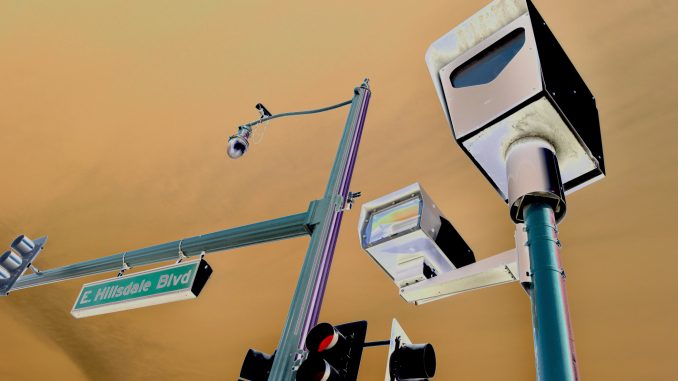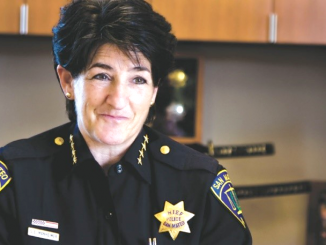
OPINION
BY DAVE PRICE
Daily Post Editor
San Mateo has finally pulled the plug on its red-light cameras — about 10 years too late, in my opinion.
In January 2009, the Post received a tip that the yellow light was set too short at an intersection monitored by a red-light camera in San Mateo. Drivers were getting caught in the intersection unexpectedly and given tickets.
So a Post reporter set up a video camera that records 30 frames every second and recorded the stoplight cycle. He then checked the recording frame by frame and discovered that, indeed, the yellow light was shorter than federal regulations.
Then we contacted an outside expert to check our work to make sure our conclusions were correct.
They were, and we printed the story.
The reaction from the San Mateo’s police and public works departments was immediate. They said our story was wrong, and the yellow light was set correctly. Case closed.
The insinuation from city officials was that the Post was irresponsible and that we were just looking for a sensational headline.
Their quick response surprised me. I was hoping they would replicate our method of measuring the duration of the yellow light before declaring our research to be incorrect.
Why not check our results?
They admitted they didn’t field test the lights by going outside and actually measuring their duration to see if they were accurately timed.
The speed with which they denied our report, and the fact that they didn’t try to verify our conclusions, made me suspicious.
Maybe I’m naive, but I thought the job of police was to get to the truth.
In November 2015, NBC Bay Area did substantially the same story we did — clocking the yellow lights at the same red-light camera intersections in San Mateo. They too found the yellow light was set too short.
This time, instead of a quick denial, San Mateo threw out 948 tickets and said it would be setting the yellow light to the correct amount of time.
You’d think that after these two reports, Police Chief Susan Manheimer and other city officials would go to great lengths to ensure the yellow light was timed correctly.
San Mateo’s third strike
But on July 11, San Mateo officials admitted it happened again. They issued a press release saying the yellow light had, once again, been set too short on a stoplight monitored by a red-light camera. The city said in a statement that the light at Saratoga Drive and Hillsdale Boulevard had been “inadvertently” set to 3.4 seconds when the state minimum is 3.6 seconds.
As a result, the city said it would be throwing out 985 tickets issued between Dec. 4 and May 20.
Nobody at City Hall or the police department was fired over this. All that happened is that the city canceled its contract with the company that runs the cameras, Redflex, whose former CEO went to prison in 2017 for bribing Chicago officials to win contracts. It’s a wonder the city of San Mateo continued to do business with that company after the CEO’s guilty verdict.
A local government fad
Red-light cameras were a municipal government fad in the early 2000s. Cities saw them as devices that would both reduce accidents and bring in revenue.
The fad peaked in 2012 when 540 cities and counties were using red-light cameras, according to the Insurance Institute for Highway Safety.
Menlo Park, Redwood City, San Carlos, Belmont and Cupertino have all shut down their red-light cameras. San Mateo was the last mid-Peninsula city to stick with them. They still operate farther north in Daly City, Millbrae and San Francisco.
Public opposition
Public opinion is very much against the cameras from what I’ve gathered. I think people would rather get a ticket from a real police officer, who can exercise discretion and sometimes give out a warning with a lecture. Most cops don’t care how much revenue a city brings in, they’d rather save somebody’s life by persuading them to drive more safely in the future.
Another problem is that if you tried to challenge a red-light ticket in court, you wouldn’t have the right to face your accuser, as is required by the Constitution. That’s because the accuser is a machine. Sure, somebody from the police department would show up at the court hearing to say the machine was running correctly, but how do you challenge that?
And lawyers questioned whether it was legal for the city to serve tickets on citizens through the mail, rather than in person. Is a summons valid if it’s sent through the mail? Usually, the answer is no. But the courts in San Mateo County said it would be OK in the case of red-light tickets. However, in 2011, the Superior Court in Los Angeles County decided the mail summonses weren’t valid — and if a motorist didn’t show up in court, there would be no consequences.
Then there’s the suspicion that the city is simply using the cameras to increase revenue. In the fiscal year that ended in June, San Mateo’s portion of the tickets was $742,645. After paying Redflex its $239,000 fee and funding the other costs of the red-light camera program, the city’s profit was $266,986.
There’s even an income inequality argument against red-light cameras. The tickets, at about $500 each, have a more devastating impact on a poor or middle-income family than they do on the wealthy. Is there a better way to improve a driver’s behavior than literally taking food off the table?
Safety argument doesn’t hold up
Supporters of red-light cameras have argued that they reduce T-bone crashes by people running the light. But studies have shown that over time, the number of rear-end crashes caused by people trying to avoid a photo ticket surpasses the T-bone crashes. In San Mateo, the number of accidents at the red-light camera intersections are higher now than they were when the cameras went in.
“These cameras are simply not having the same effect on improving drivers’ behaviors as they once were,” San Mateo City Manager Drew Corbett said in his announcement about dropping the cameras. “We believe focusing our efforts on uniformed patrols and education will have a greater benefit.”
It’s too bad that it took a decade for the city to reach that conclusion.
Editor Dave Price’s column appears on Monday. His email address is [email protected].




The for-profit racket aspects of red light cameras have been known for decades. Yellow intervals too short for the actual conditions are one scam, ticketing safe slow rolling right on red turns that almost never cause crashes is another. San Mateo just decided to end their for-profit racket to spare mostly safe drivers from having money stolen from them. The city became the 83rd California community to end or ban red light camera programs, leaving only 28 active red light camera rackets in a state that once had over 100. Thanks, San Mateo.
James C. Walker, National Motorists Association
What we need is somebody to watch over the police when they set something like this up. It’s a total scam and yet there’s no oversight, no supervision. And even when they get caught red handed, they just deny it and get away with the scam.
If a private business pulled a scam like this, the CEO would be behind bars.
A t-bone crash is *much* more likely to be fatal than a rear-end crash. I agree with the article as a whole but the relative incidences of T-Bone versus rear-end crashes is not a good argument for getting rid of red light cameras.
Red light cameras are set up to take peoples money Need to pay my money back for bogus cameras
Had red light cameras in AZ. All about revenue not safety. Some cities removed them when ppl largely stopped going into those areas. Quit spending money in areas where they are. Avoid these areas if at all possible
The behavior described here undermines the confidence the public has in the San Mateo Police Department.
Why is it that wide use of red-light and speed cameras have long been standard and growing all over the rest of the world’s developed countries, relieving police of the mindless drudgery of doing a relatively dangerous job for which they are overpaid and overqualified for? Some countries even use networked average speed cameras which read license plates and calculate which cars have travelled certain distances (routes) so quickly that they mathematically *had to* be speeding.
US Automated traffic law enforcement are merely hiding their desire to continue to get away with frequent and rampant daily violations by citing specious and irrelevant arguments against even correctly- and legally-implemented deployments. Meanwhile, the EU already has approved plans to require all new cars sold after a certain date to know and enforce speed limits using a combination of GPS and other onboard technology!
Here we are in the tech capital of the world and can’t (refuse to) even make the technology in wide use all over the world make our streets, roads and highways safer. What’s not often widely acknowledged is that historically, police union opposition (featherbedding “job protection”) to automated enforcement is part of the problem here in the US, too.
I got a nailed in exactly the same way a few years ago at the intersection of Menlo Ave. and El Camino in Menlo Park. Not sure if that scam cam is still being used today.
The red light camera was a bad idea from the get go. There’s the perception that government officials just want more income. Also, you get more accidents because of slamming breaks when the yellow hits. Apparently, you can just not even show up when you get a ticket in the mail. But “income inequality?” Come now. Just don’t run the red light. Are you saying that it’s ok to let poor people run red lights because they’re poor?
It’s not saying poor people can run red lights. It’s saying the punishment is unfair. 500 dollars for a
red light tickett is absolutely ridiculous and will literally devestate a poor family for something so menial.
The cameras were at Hillsdale and Saratoga, Hillsdale and Norfolk, and 4th and Humbodt. The camera maps show no cameras on El Camino, which borders the wealthier westside residential sections of town. The residents and business employees on the eastside of town had higher risk of getting ticketed. This could raise the question of economic bias.
Same can be said in Menlo Park. The city council put two cameras at intersections Belle Haven, an economically disadvantaged neighborhood with a high percentage of racial minorities. They also were considering putting one on Sand Hill Road, which would ticket white Sharon Park residents and billionaire venture capitalists. Council decided against the Sand Hill Road camera but kept the Belle Haven cameras going until earlier this year.